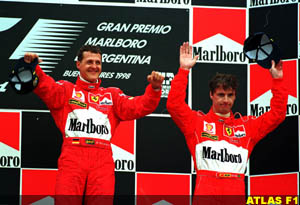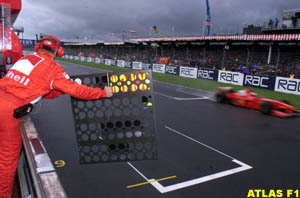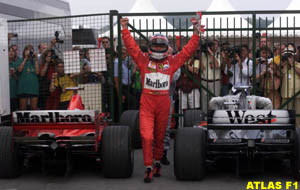|
While some may remember this season as one where Michael Schumacher battled the mighty McLaren-Mercedes, for me this season will be remembered as one where the German buried a few ghosts, taking victory at three tracks that in the past have not been very kind to him. By winning the Argentinean and British Grand Prix, Schumacher has shortened the list of tracks on the current calendar that he hasn't won on to two (Albert Park in Melbourne and the A1 Ring in Austria). And by winning this weekend in Hungary he finally doubled up at a track where he has had some of his worst memories ever.
Buenos Aires, Argentina
The Argentinean Grand Prix was re-introduced to the Formula One circus in 1995. Since then, Schumacher usually qualified well but his race pace was often no where near what it would have taken to win.
 In 1995 Schumacher, in a Benetton, finished a puzzling third behind Damon Hill's Williams and Jean Alesi's Ferrari. If not for David Coulthard's DNF it would have been very likely that Schumacher would not have even finished on the podium. And whilst Hill was on the same three stop strategy with better overall pace, Alesi was on a two stopper, out- strategizing the Benetton team. In 1995 Schumacher, in a Benetton, finished a puzzling third behind Damon Hill's Williams and Jean Alesi's Ferrari. If not for David Coulthard's DNF it would have been very likely that Schumacher would not have even finished on the podium. And whilst Hill was on the same three stop strategy with better overall pace, Alesi was on a two stopper, out- strategizing the Benetton team.
1996 saw Schumacher second on the grid, but again his car - this time the Ferrari F310 - lacked pace. Schumacher was running second when he retired with a broken rear wing, damaged by debris from an earlier accident. Both 1995 and 1996 saw Schumacher bested by a dominant Williams car driven by Damon Hill. However, while Williams may have had a dominant package for the 1997 race, it was a first lap accident with Ruebens Barichello that spoiled a potential good result for the German.
This year's Argentinean race was not only Schumacher's first win there: it was also the first time this season that Schumacher, or anyone else for that matter, was able to out-qualify a McLaren, splitting Coulthard and Hakkinen, on his way to his first win of the season. The victory, however, was not without controversy. An early collision with then leader David Coulthard saw Schumacher come off best, which left him a clear track to build up a lead over his closest rival Hakkinen. While blame has been assigned to both parties, depending on one's viewpoint, the fact that Schumacher was able to out-pace the other McLaren is significant.
Silverstone, England
If Schumacher dreaded one race track, it would probably be Silverstone. Some of the most frustrating occurrences in his career have happened at "the home of British Motor Racing".
 Schumacher's first race at Silverstone in 1992 saw him qualify fourth, behind the two Williams and Ayrton Senna's McLaren. But when the green light came on he was beaten into the first corner by his team-mate Martin Brundle who was sixth on the grid. He ran as far back as sixth behind both McLarens, both Williams', and his teammate, but did get ahead of Gerhard Berger. Senna's running out of fuel in the last few laps promoted him to fourth, but he was still bested by Brundle by quite a margin. Schumacher's first race at Silverstone in 1992 saw him qualify fourth, behind the two Williams and Ayrton Senna's McLaren. But when the green light came on he was beaten into the first corner by his team-mate Martin Brundle who was sixth on the grid. He ran as far back as sixth behind both McLarens, both Williams', and his teammate, but did get ahead of Gerhard Berger. Senna's running out of fuel in the last few laps promoted him to fourth, but he was still bested by Brundle by quite a margin.
Schumacher's fortunes improved the next year as he was able to qualify in third place, once again behind the two Williams drivers. Although Senna got by Schumacher's Benetton and Prost's Williams at the start, both drivers eventually passed the Brazilian in a protracted mid-race battle. Both drivers also benefitted from a late race engine failure by Prost's teammate Damon Hill. Prost finished first, and Schumacher inherited second.
There are few races that can match the 1994 British race for controversy. Schumacher, second on the grid, overtook pole sitter Damon Hill during what would eventually be the first formation lap, as David Coulthard stalled his Williams on the grid. Even though the race was to have another formation lap, Schumacher was given a 5 second stop and go penalty for his efforts. His Benetton team, in trying to get the penalty overturned, left Schumacher out longer than was allowed and he was eventually disqualified from his second place, and subsequently given a two race ban for ignoring the black flag.
More recent races are marked with an accident and poor reliability. In 1995 race leading Schumacher was taken out by Hill, who was trying an over-optimistic maneuver. 1996 saw Schumacher's Ferrari, in a sequence of horrid run of unreliability, retire early. In 1997 he retired from the lead after his second pit stop with a wheel bearing failure, thus erasing a potential first ever Silverstone triumph.
While this year's race may well match 1994 for controversy, Schumacher's pace while on full wets was astonishing. Both McLarens had major off-track moments which lead to Coulthard's retirement, and Hakkinen's reduced pace. I find it funny that all of this controversy could have been avoided had the stewards properly reviewed the incident for which Schumacher was penalized. They recently admitted that in hindsight a penalty shouldn't have been assessed owing to the poor visibility on the track when the yellow flag was waved. Regardless, the stewards made mistakes both in Schumacher's favor, and not in his favor during the race weekend. But, as confusion ruled after the race regarding the result, another ghost had been put to rest.
Hungaroring, Hungary
 Although Schumacher has won the Hungarian once before, in 1994, he has had some of his worst luck when it comes to reliability at the Budapest circuit. In 1992, while running in fourth in his Benetton, he lost his rear wing. 1993 it was an engine blow up that ended a lack lustre race. 1995 saw him retire with an engine problem while running in second place, although he never really harried his title rival Damon Hill in his Williams. Furthermore, In both 1995 and 1996 he was classified as a finisher even though he in fact did retire on both years. Although Schumacher has won the Hungarian once before, in 1994, he has had some of his worst luck when it comes to reliability at the Budapest circuit. In 1992, while running in fourth in his Benetton, he lost his rear wing. 1993 it was an engine blow up that ended a lack lustre race. 1995 saw him retire with an engine problem while running in second place, although he never really harried his title rival Damon Hill in his Williams. Furthermore, In both 1995 and 1996 he was classified as a finisher even though he in fact did retire on both years.
Last year saw Schumacher dominate the entire weekend, that is up until race day. In the morning warm-up he had a shunt which damaged the floor of his new "lightweight" Ferrari chassis. It is unclear whether the new chassis would have been able to resist the tire balance problem that plagued both standard Ferrari chassis during the race, but the damage was done nonetheless. Schumacher was lucky to salvage a fourth place from a race where he had pole position, and looked to be on the brink of dominating after Saturday qualifying.
Sunday's 1998 Hungarian race was a strategic masterpiece from Ferrari. The team had nothing to lose by going for a three stop race, as Hill and Villeneuve were never close enough to challenge Schumacher's position and the gamble was simple - could Schumacher open up the 25+ seconds needed for him ton retain his lead after the final stop, or not. At the very worst, he would have finished second (third, had Hakkinen not been in trouble of his own). But the Ferrari gamble worked, because of the that which Frank Willians calls "the M factor": Schumacher's middle stint was a brilliant display of one fast lap after another, a dominant performance in a Formula One car, only enhanced by the mighty McLaren's sluggishness. As it were, another ghost has been put to rest.
|

